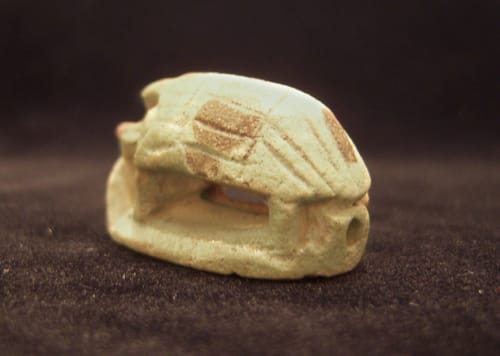Faience Amulet Seal in the Form of a Porcupine, 664 BCE - 525 BCE
Faience
0.625 x 0.75 x 1.25
PF.2995
Further images
Ancient Egyptian artists faced a dilemma. Although they had worked in clay for thousands of years, they had not mastered the glazing technique. But a modest material solved that problem...
Ancient Egyptian artists faced a dilemma. Although they had worked in clay for thousands of years, they had not mastered the glazing technique. But a modest material solved that problem and became revered. Faience, which dates back to pre-dynastic times, of at least 5,000 years, is a glasslike non-clay substance made of materials common to Egypt: ground quartz, crushed quartz pebbles, flint, a soluble salt-like baking soda, lime and ground copper, which provided the characteristic color. The dried objects went into kilns looking pale and colorless but emerged a sparkling "Egyptian blue." Called tjehnet by the ancient Egyptians, meaning that which is brilliant or scintillating, faience was thought to be filled with the undying light of the sun, moon and stars and was symbolic of rebirth. Ancient Egyptians believed the small blue-green objects helped prepare them for eternity in the afterlife. This diminutive seal pendant is a masterpiece of intricacy. Originally, this ancient statuette would have been attached a chord and worn as a bracelet or necklace. Drilled holes just above the base attest to this use. Formed in the image of a porcupine, that spiny rodent that was hunted in Ancient Egypt for sport and food, the seal features the representation of a crocodile etched onto the base. When pressed onto wet clay or wax, this seal would have been used to ensure that a message or shipment of merchandize was not tampered with while en route to the hands of its intended recipient. Certain objects, masterpieces treasured in their own time, are of an eternal beauty that is easily appreciated regardless of era or culture. This amulet is one such stunning example; a reminder of how close the Ancient Egyptians were to their natural environment and the great diversity of wildlife that lived alongside them.





